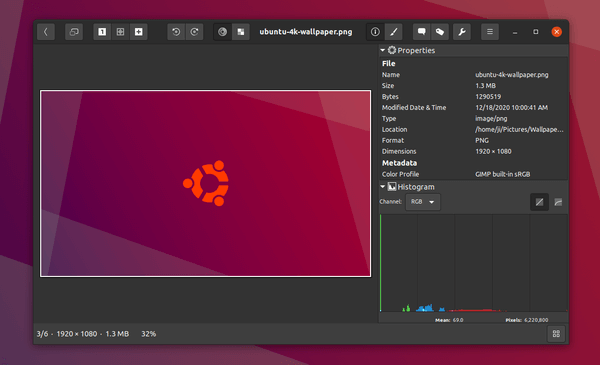How To Install gThumb on Ubuntu 24.04 LTS

gThumb is an advanced image viewer and browser for the GNOME desktop environment that offers a wide array of features, making it a favorite among Linux users. It allows you to easily browse your filesystem for images, present them in engaging slideshows, create image catalogs, and even generate web albums. Whether you are a casual user or a photography enthusiast, gThumb provides the tools you need to manage and view your image collections effectively. This guide will walk you through the process of installing gThumb on Ubuntu 24.04 LTS (Noble Numbat), providing step-by-step instructions for both the APT and Flatpak installation methods. We’ll cover each method in detail, including the advantages and disadvantages, to help you choose the best option for your needs.
Ubuntu 24.04 LTS is a Long Term Support release, meaning it receives updates and security patches for five years, making it a stable and reliable choice for both desktop and server environments. Installing gThumb on this platform ensures you have a dependable image viewer that integrates seamlessly with your system. Let’s get started!
Prerequisites
Before we dive into the installation process, let’s ensure that you have everything you need. Here are the prerequisites:
- A working Ubuntu 24.04 LTS installation: This guide assumes you already have Ubuntu 24.04 LTS installed and running on your system.
- A stable internet connection: You will need an active internet connection to download the necessary packages.
sudoprivileges: You need to havesudoprivileges to install software on Ubuntu. This allows you to run commands with administrative rights.- Basic knowledge of the Linux terminal: While this guide provides detailed instructions, some familiarity with the Linux terminal will be helpful.
Updating Ubuntu Before gThumb Installation
Updating your Ubuntu system before installing any new software is a best practice. Updating ensures that you have the latest security updates, bug fixes, and system improvements. This can prevent potential conflicts during the installation process and ensure that gThumb runs smoothly on your system. To update your system, open the terminal and run the following commands:
sudo apt update && sudo apt upgradeLet’s break down this command:
sudo: This command elevates your privileges to that of the superuser, allowing you to make system-level changes.apt update: This command refreshes the package lists, downloading the latest information about available packages and their versions.apt upgrade: This command upgrades all installed packages to their newest versions. It’s important to keep your system up-to-date to maintain stability and security.
After running these commands, your system will be up-to-date, and you can proceed with the gThumb installation.
Method 1: Install gThumb via Ubuntu Default Repository
The Ubuntu default repository provides a stable and secure version of gThumb. This method is straightforward and ensures that gThumb integrates well with your system. However, the version available in the default repository might not be the latest.
Installing gThumb via APT Command
To install gThumb using the APT package manager, open the terminal and enter the following command:
sudo apt install gthumbThis command instructs APT to install the gThumb package. Here’s a breakdown:
sudo: As mentioned earlier, this gives you the necessary administrative privileges.apt install: This is the command used to install a new package.gthumb: This is the name of the package you want to install.
Once you run the command, APT will download and install gThumb along with any required dependencies. You may be prompted to confirm the installation by typing Y and pressing Enter.
Verifying the Installation
After the installation is complete, you can verify that gThumb has been successfully installed. There are a couple of ways to do this:
- Using
apt show gthumb:
Run this command in the terminal to display information about the installed package:
apt show gthumbThis command will show details such as the version number, description, and dependencies of gThumb. It confirms that the package is installed correctly.
- Using
gthumb --version:
Run this command to display the version number of gThumb:
gthumb --versionThe output will show the version number of the installed gThumb, confirming its successful installation.
Launching gThumb After APT Installation
Now that gThumb is installed, you can launch it in several ways:
- From the terminal: Simply type
gthumbin the terminal and press Enter.
gthumb- From the GUI: You can find gThumb in the Activities menu. Click on “Show Applications” and then locate the gThumb icon. Click on the icon to launch the application.
Method 2: Install gThumb via Flatpak and Flathub
Flatpak is a universal package management system that allows applications to run consistently across various Linux distributions. Installing gThumb via Flatpak offers several advantages:
- It provides a more isolated environment for the application, reducing the risk of conflicts with other software.
- Flatpak often hosts more recent versions of applications compared to the default Ubuntu repository.
- It ensures consistent performance across different systems.
Installing Flatpak (if needed)
If you don’t have Flatpak installed on your system, you need to install it first. Open the terminal and run the following command:
sudo apt install flatpakThis command installs the Flatpak package manager. After the installation, it’s recommended to add the Flatpak plugin for GNOME Software, which allows you to install Flatpak apps from the Software Center:
sudo apt install gnome-software-plugin-flatpakTo ensure that all changes are applied, restart your system:
sudo rebootEnabling Flathub for gThumb
Flathub is the primary repository for Flatpak applications. To enable Flathub, run the following command in the terminal:
sudo flatpak remote-add --if-not-exists flathub https://flathub.org/repo/flathub.flatpakrepoThis command adds the Flathub repository to your Flatpak configuration. The --if-not-exists option ensures that the repository is only added if it’s not already present.
Install gThumb via Flatpak Command
With Flatpak and Flathub set up, you can now install gThumb using the following command:
flatpak install flathub org.gnome.gThumb -yThis command tells Flatpak to install gThumb from the Flathub repository. The -y option automatically answers “yes” to any prompts, allowing the installation to proceed without interruption.
Launching gThumb After Flatpak Installation
After the installation is complete, you can launch gThumb in the following ways:
- From the terminal: Use the following command:
flatpak run org.gnome.gThumb- From the GUI: As with the APT method, you can find gThumb in the Activities menu. Click on “Show Applications” and then locate the gThumb icon. Click on the icon to launch the application.

Using gThumb
Once gThumb is installed, you can start using it to manage and view your images. Here are some basic operations you can perform.
Basic Image Viewing
- Opening an image: To open an image, simply double-click on it in the file manager. gThumb will open the image in its main window.
- Navigating images: You can use the arrow keys to navigate to the next or previous image in a folder. The toolbar also provides buttons for navigation.
- Zooming: Use the mouse wheel or the zoom slider in the toolbar to zoom in and out of the image.
- Fullscreen mode: Press
F11to enter fullscreen mode for an immersive viewing experience.
File System Browsing
gThumb allows you to browse your file system to locate images:
- Sidebar: The sidebar displays your file system, allowing you to navigate to different folders.
- Bookmarks: You can add bookmarks for frequently accessed folders by dragging them to the bookmarks section in the sidebar.
- Filtering: Use the filter options to display only image files in a folder.
Image Catalogs
gThumb supports image catalogs, which allow you to organize your images into collections:
- Creating a catalog: Go to “File” > “New Catalog” to create a new image catalog.
- Adding images: Drag and drop images from your file system into the catalog.
- Adding comments: You can add comments to individual images by right-clicking on the image and selecting “Properties.”
Basic Editing Tools
gThumb provides basic editing tools for image manipulation .
- Cropping: Use the crop tool to select a portion of the image and remove the rest.
- Resizing: Resize images to different dimensions using the resize tool.
- Color adjustments: Adjust brightness, contrast, saturation, and hue using the color adjustment tools.
- Filters: Apply various filters to enhance your images.
Troubleshooting
Even with detailed instructions, you might encounter issues during the installation or usage of gThumb. Here are some common problems and their solutions:
gThumb Not Launching
If gThumb fails to launch after installation, try the following:
- Check the installation: Verify that gThumb is properly installed by running
apt show gthumb(for APT) orflatpak list(for Flatpak). - Ensure Flathub is configured correctly: If using Flatpak, make sure Flathub is properly configured as a remote repository.
- Check dependencies: Missing dependencies can prevent gThumb from launching. Use the methods described below to check and install any missing dependencies.
Missing Dependencies
Missing dependencies can cause gThumb to malfunction. To identify and resolve this issue:
- Identify missing dependencies: Use the
lddcommand to list the dynamic dependencies of gThumb. For APT installations, run:
ldd /usr/bin/gthumbFor Flatpak installations, use:
flatpak run --command=ldd org.gnome.gThumbLook for any dependencies that are marked as “not found.”
- Install missing dependencies: Use APT or Flatpak to install the missing dependencies. For example, if
libjpeg.so.0is missing, run:
sudo apt install libjpeg0or, if using Flatpak:
flatpak install flathub [missing-dependency]Removable Media Access
If gThumb cannot access removable media (e.g., USB drives), you might need to adjust the permissions:
- Snap installations: If you installed gThumb via Snap, connect the removable media interface:
sudo snap connect gthumb-unofficial:removable-media :removable-media- Flatpak permissions: For Flatpak, ensure that gThumb has the necessary permissions to access removable drives via Flatseal or the command line.
Alternative Installation Methods
Besides APT and Flatpak, you can also install gThumb using Snap. Snap is another package management system that provides containerized applications. However, APT and Flatpak are generally recommended due to better integration and update management.
Installing gThumb via Snap
To install gThumb using Snap, run the following command:
sudo snap install gthumb-unofficialNote that this is an unofficial Snap package. After installation, launch gThumb using the command gthumb-unofficial.
Uninstalling gThumb
If you no longer need gThumb, you can uninstall it using the same package manager you used to install it.
Uninstalling gThumb Installed via APT
To uninstall gThumb installed via APT, run the following command:
sudo apt remove gthumbThis command removes the gThumb package. To remove any unused dependencies, you can run:
sudo apt autoremoveUninstalling gThumb Installed via Flatpak
To uninstall gThumb installed via Flatpak, use the following command:
flatpak uninstall org.gnome.gThumbThis command uninstalls gThumb from your system.
Uninstalling gThumb Installed via Snap
To uninstall gThumb installed via Snap, use the following command:
sudo snap remove gthumb-unofficialCongratulations! You have successfully installed gThumb. Thanks for using this tutorial for installing the gThumb photo manager and image viewer on Ubuntu 24.04 LTS system. For additional help or useful information, we recommend you check the official gThumb website.